
Arthur Lawley, 6th Baron Wenlock, was a British colonial administrator who served variously as Administrator of Matabeleland, Governor of Western Australia, Lieutenant-Governor of the Transvaal, and Governor of Madras. The fourth and youngest son of the 2nd Baron Wenlock, he attended Eton College and Trinity College, Cambridge, before joining the military. Serving in the Mahdist War, he reached the rank of captain before resigning his commission to pursue other interests. Lawley was then private secretary to his uncle, the 1st Duke of Westminster, and subsequently to the 4th Earl Grey, who he followed to Rhodesia.
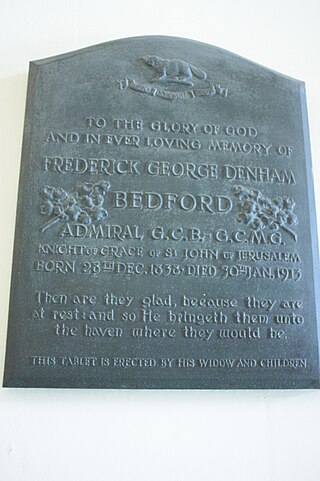
Admiral Sir Frederick George Denham Bedford, was a senior Royal Navy officer and Governor of Western Australia from 24 March 1903 to 22 April 1909.
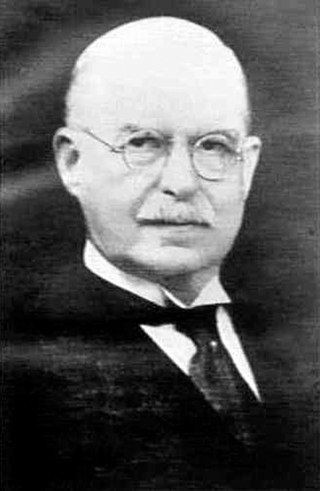
Gerald Paul Joseph Cajetan Carmel Antony Martin Strickland, 6th Count della Catena, 1st Baron Strickland, was a Maltese and British politician and peer, who served as Prime Minister of Malta, Governor of the Leeward Islands, Governor of Tasmania, Governor of Western Australia and Governor of New South Wales, in addition to sitting successively in the House of Commons and House of Lords in the Parliament of the United Kingdom.
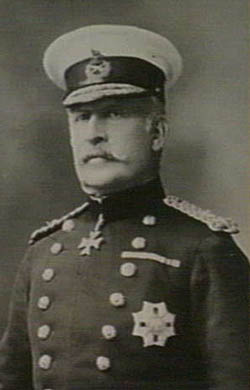
Major General Sir Harry Barron, was a British Army officer who served as Governor of Tasmania from 1909 to 1913, and Governor of Western Australia from 1913 to 1917.

Sir William Grey Ellison-Macartney, was an Irish-born British politician, who also served as the Governor of the Australian states of Tasmania and Western Australia.
The following lists events that happened during 1909 in the Commonwealth of Australia.
The following lists events that happened during 1916 in Australia.
The following lists events that happened during 1915 in Australia.
The following lists events that happened during 1917 in Australia.
1914 in Australia was dominated by the outbreak of World War I. Andrew Fisher, who became Prime Minister a month after Australia entered the war vowed that Australia would "stand beside our own to help and defend Britain to the last man and the last shilling." In 1914, the Australian war effort was dominated by recruiting and equipping a force to fight overseas.

The Lady Barron Falls, a tiered–cascade waterfall on the Lady Barron Creek, is located in the Central Highlands region of Tasmania, Australia.

Zara Hore-Ruthven, Countess of Gowrie was the Anglo-Irish wife of the 1st Earl of Gowrie, Governor of South Australia 1928–34, Governor of New South Wales 1935–36 and the longest serving Governor-General of Australia 1936–44. She was renowned for her work in promoting the welfare of children in Australia, and the Lady Gowrie Child Centres were named in her honour.
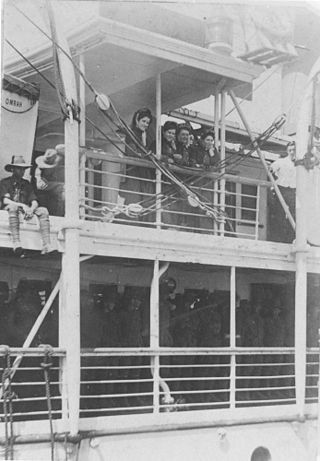
The role of Australian women in World War I was focused mainly upon their involvement in the provision of nursing services. Australian women also played a significant role on the Homefront, where they filled jobs made vacant by men joining the armed forces. Women also undertook fundraising and recruiting activities as well as organising comfort packages for soldiers serving overseas. Around the issue of conscription, women were involved in campaigning on both sides of the debate, while they were also equally involved in the New South Wales strike in 1917. Nevertheless, despite this involvement, women have never occupied a central position in the Australian version of the Anzac legend, although since the 1970s their role has been examined in more detail as a result of the emergence of feminist historiography, and specialist histories such as the history of nursing.
Lady Barron is a small settlement on the southern end of Flinders Island, in the local government area of Flinders in the North-east region of Tasmania. It is located about 28 kilometres (17 mi) south-east of the town of Whitemark. The 2016 census determined a population of 158 for the state suburb of Lady Barron.

Anzac Cottage is a house in the suburb of Mount Hawthorn, Western Australia that was built as both a memorial to the soldiers who died in the Gallipoli Campaign and as a home for one of the wounded returning men. It is notable for being the first World War I memorial built in Western Australia, and for (nominally) being built in a single day with donated funds, materials and labour.
Alice Eyton, sometimes credited under her married name Alice von Saxmar, was a New Zealand–born journalist, screenwriter, playwright, and novelist active in Hollywood between 1918 and 1922.
The Prince of Wales Theatre was a theatre on Macquarie Street, Hobart, Tasmania from 1910 to 1987.
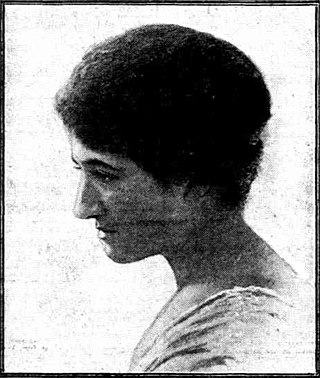
Clara Serena Kleinschmidt was an Australian operatic contralto singer, professionally known as Clara Serena. She had a successful career in London and in Europe, which was interrupted by the World War I, and resumed in 1923 with Roy Mellish, her accompanist and husband. They retired to South Australia in 1951.
Lady Don, born Emilia Eliza "Emily" Saunders was an English singer and actor who enjoyed great popularity in Australia. She married an actor, Sir William Henry Don, Bart., who died in Hobart, Tasmania on 18 March 1862.

Lady Elsie Goold-Adams formerly Elsie Riordan, was a Canadian born Australian who was the inaugural president of the Queensland division of the Australian Red Cross and led the activities of the division during World War I. During this time she was also a charity patron for causes relating to supporting soldiers in the war effort, advancing the roles of women, and child education and welfare. She was married to Sir Hamilton John Goold-Adams, the 12th Governor of Queensland.












